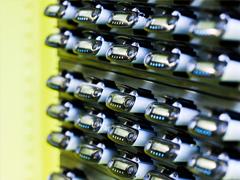Radiation protection
In view of the different nuclear plants located in the region, the lower Aare valley is one of the most intensively monitored areas in Switzerland. A widespread network of measuring stations in the near and far vicinity of the central interim storage facility constantly monitors direct radiation and emissions in the air, water system (rivers, groundwater, precipitation) and food chain (soil samples, grass, plant foods and milk). The results of these measurements are published by the authorities every year. The decades-old official monitoring of radioactivity shows that the radiation impact of nuclear plants in the lower Aare valley equals a few hundredths of a millisievert per year at most. This is negligible compared to the average radiation dose of around four mSv per year to which the Swiss population is exposed. This small additional radiation dose from nuclear power plants falls well within the fluctuation band for the annual dose, which differs according to geographic location, type of residential buildings (radon) and individual lifestyle (medical attention, vacations).

How do we protect the environment from radioactivity?
The building consists of reinforced concrete, and in addition to shielding the environment from direct radiation also provides a high level of protection against external influences. The low pressure in the operating buildings ensures that only air can penetrate the building in the event of a leak. Preventive measures include the permanent monitoring and maintenance of the facilities, which ensure safe operations.

How do we protect our employees and visitors from radiation?
The area where employees working regularly could absorb an accumulated dose of more than 1 mSv per year is known as the 'controlled zone'.Additional measures are applied for people in the controlled zone in order to protect the employees and visitors and also to avoid the outside transfer of radioactive materials. This includes changing clothes and shoes, wearing a dosimeter, limiting the time spent in this zone, avoiding radiation sources, and carefully measuring levels of radioactivity before leaving the controlled zone. Eating and drinking in the controlled zone are prohibited in order to avoid the ingestion of radioactive materials via the lungs or stomach as much as possible.
The radioactive contamination of the employees has always been well below the legal limit of 20 mSv per person per year, which applies to everybody who is professionally exposed to ionising radiation, including medical staff (e.g. X-ray technicians and people involved in the treatment of cancer patients). By way of comparison, natural radiation in the Black Forest (in Menzenschwand) is 20 mSv per person per year.
